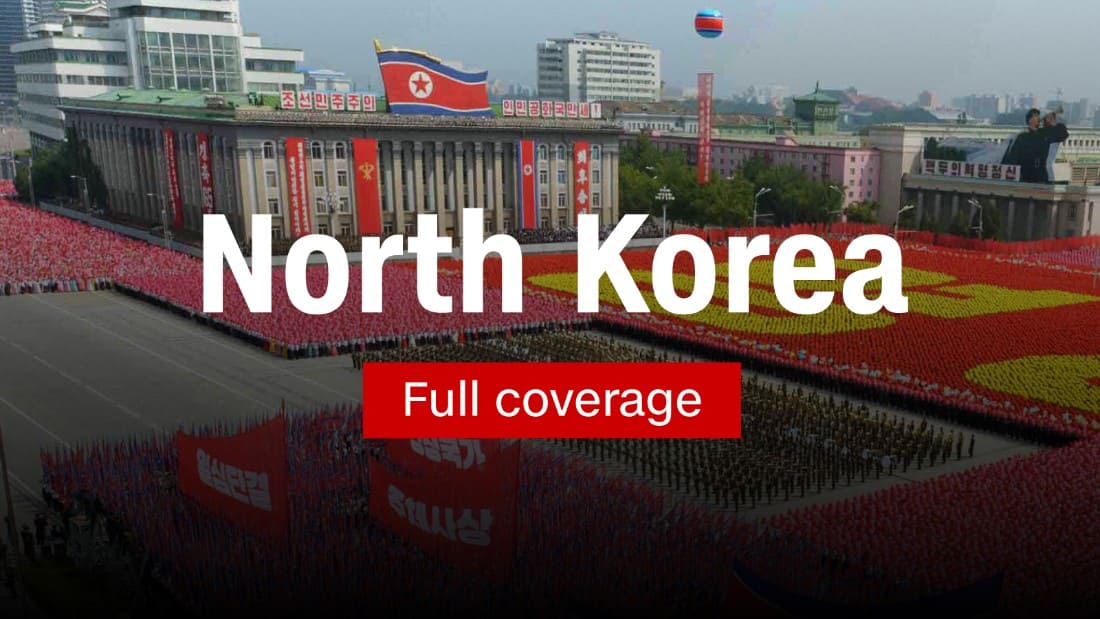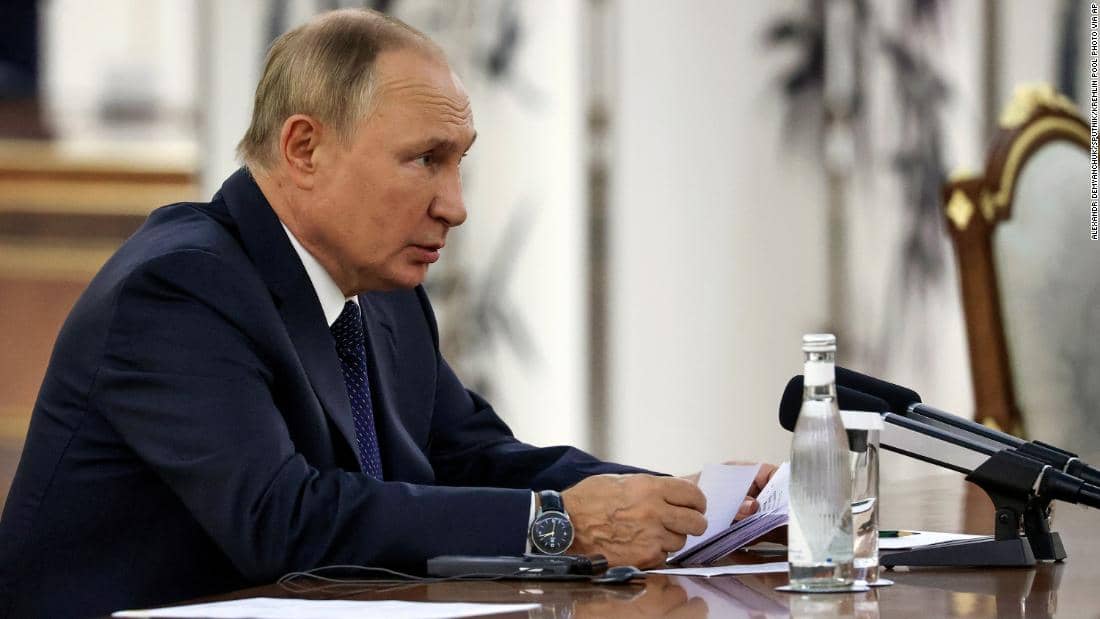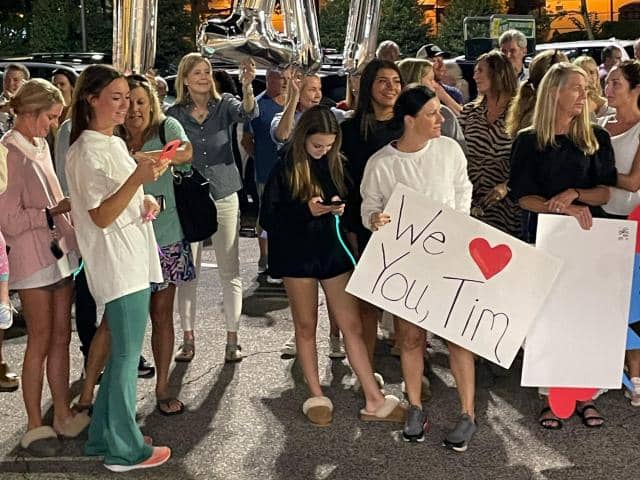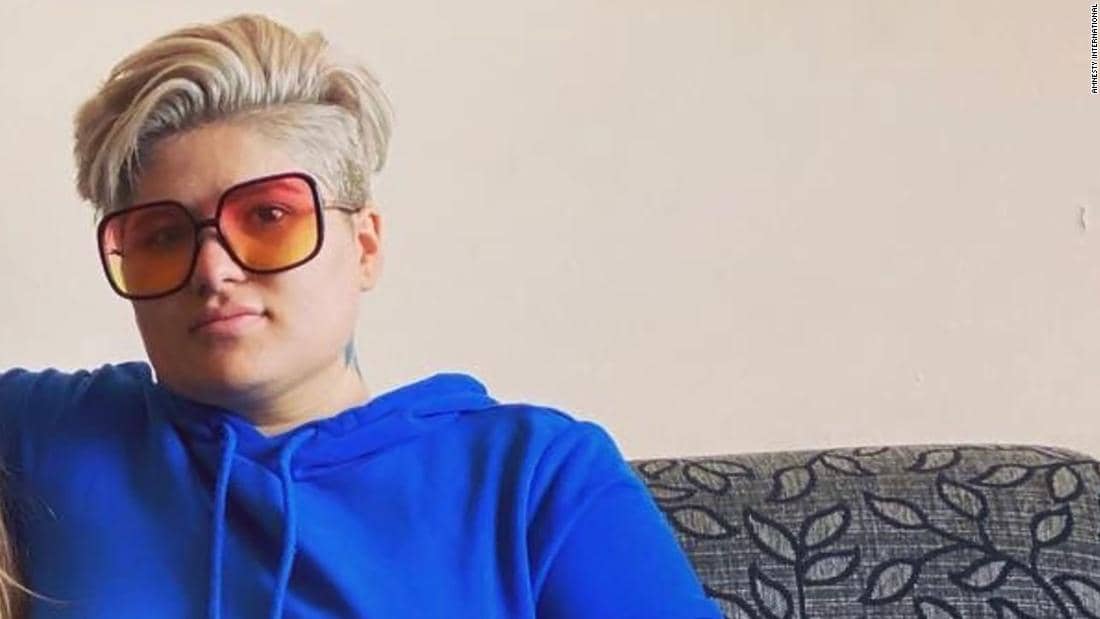The leader of the world’s most isolated country Kim Jong Un has flouted international sanctions to develop North Korea’s weapons program — viewed as a direct threat to neighboring South Korea and
CNN
—
Here’s a look at the Australian Open, one of four competitions that make up the “Grand Slam” in professional tennis. The other three are Wimbledon, the French Open and the US Open.
January 13-28, 2024 – The 112th Australian Open takes place.
January 16-29, 2023 – The 111th Australian Open takes place.
The tournament is played at Melbourne Park, in Melbourne, Australia.
The Australian Open is played on hard courts with a blue surface.
Jannik Sinner overcomes a two-set deficit to defeat Russia’s Daniil Medvedev in a five-set final and claims the men’s Australian Open title, becoming the first Italian man to win a grand slam since 1976.
Aryna Sabalenka successfully defends her Australian Open women’s title, defeating China’s Zheng Qinwen in the final.
Novak Djokovic defeated Stefanos Tsitsipas in straight sets to win a 10th Australian Open title and a record-equaling 22nd grand slam.
Belarusian-born Aryna Sabalenka defeated Elena Rybakina in three sets, becoming the first player competing under a neutral flag to secure a grand slam.

Total prize money for 2024 was a record high $86.5 million AUD, a 13% increase from $76.5 million AUD in 2023.
Youngest winners – men’s singles – Ken Rosewall (18); women’s singles – Martina Hingis (16)
Oldest winners – men’s singles – Rosewall (37); women’s singles – Thelma Long (35)
Most consecutive singles wins – men’s – Roy Emerson (five) 1963-1967; women’s – Margaret Court (seven) 1960-1966
Most singles titles overall – men’s – Djokovic (10); women’s – Margaret Court (11)
1905 – The Australasian Championships are played in Melbourne.
1927 – The name is changed to the Australian Championships.
1954 – Thelma Long wins the Women’s Singles Championship at 35 years and eight months, becoming the oldest female to do so.
1969 – The name is changed to the Australian Open.
1972 – Ken Rosewall wins the Men’s Singles Championship at age 37, becoming the oldest male player to win the Australian Open. Rosewall also holds the record for youngest champion, winning at age 18 in 1953.
2001 – Begins paying men and women equal prize money.
January 15-16, 2022 – World No. 1 and 2021 men’s singles champion Novak Djokovic is detained and deported from Australia over a visa and Covid-19 vaccination dispute, missing the tournament.
November 15, 2022 – Australia’s Immigration Ministry announces the repeal of Djokovic’s three-year ban from entering the country, paving the way for the nine-time singles champion to enter the 2023 Australian Open.
Don't Miss
CNN — Here’s a look at the life of professional soccer player Cristiano Ronaldo. Birth date: February 5, 1985 Birth
CNN — Novak Djokovic cruised through to the US Open final after a dominant 6-3 6-2 7-6 (7-4) win against
CNN — Here is a look at the life of Hall of Fame hockey player Wayne Gretzky, who is the
Quake and Tokyo plane fire
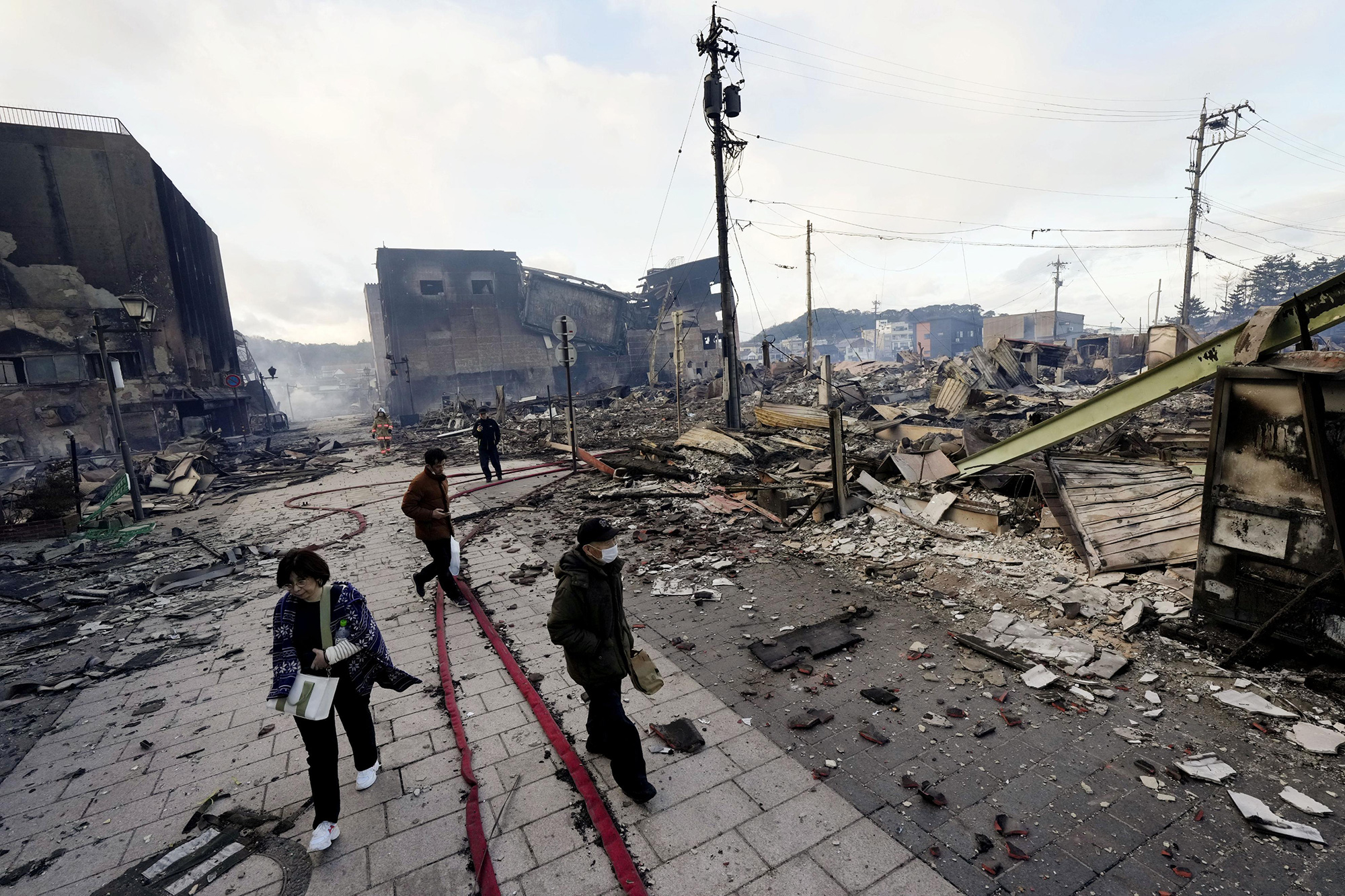
The death toll from the 7.5 magnitude earthquake that struck Japan’s west coast on Monday has risen to 57, according to Japan public broadcaster NHK, citing officials from Ishikawa prefecture.
The quake shook the Noto Peninsula in the central prefecture of Ishikawa on Monday afternoon, collapsing buildings, sparking fires and triggering tsunami alerts as far away as eastern Russia.
Japan’s Meteorological Agency lifted all tsunami advisories along portions of the country’s western coast Tuesday, but more than 24 hours after the quake struck, there has been limited access to the northern part of the secluded Noto Peninsula.
Prime Minister Fumio Kishida told reporters after a disaster emergency meeting Tuesday that a destroyed road had cut access to the area.
Officials in helicopters had flown over the peninsula, known for its coastal scenery and rural landscapes, and reported seeing damaged roads, landslides and large fires, he said.
“To secure the route there, we are to mobilize all the means of transport, not only on the ground but also by aerial and marine transport. We have been making an effort to transfer goods, supplies and personnel there since the last night,” Kishida said.
CNN’s Helen Regan, Sahar Akbarzai, Chie Kobayashi and Mayumi Maruyama contributed reporting to this post.
Don't Miss
(CNN) — It wasn’t until he moved near to an airfield in the UK over a decade ago that mechanical
She told CNN that her biology teacher in her home village in the southern Indian state of Kerala had spoken to the class about sexual intercourse just once and she didn’t recall learning much from that. So, when she found herself uncomfortable with her sexual encounters with her husband, she struggled to explain why or name what had been happening to her.
”I didn’t know about marital rape back then. I didn’t know even the term existed,” the now 32-year-old said, explaining that her husband never sought consent, nor did she realize at the time how much it might have changed her experience if he had.
Still, Manomi — whose name has been changed due to possible backlash for speaking out — was so unhappy that she says her mother “took the initiative” to help her daughter file for divorce, just three months after her wedding.
The young woman moved to the state capital and became an urban designer, but it would be years before she learned, through the social media posts of online sexual health educator Leeza Mangaldas, that sex should be “consensual, safe and pleasurable.” These “three things Leeza repeats everywhere,” Manomi said.
For Leeza Mangaldas’s 2.5 million followers across Instagram, YouTube and Facebook, she is a source of accessible and empowering information on sexual health and wellbeing — a subject that remains largely taboo across India and most of the Asia-Pacific region. According to the educator’s own analytics, 65% of her followers on Instagram are men and women between the ages of 18 and 34.
But Mangaldas’ ability to share information that her audiences tell her is useful, and which they say they are unable get elsewhere, is being hampered by changes to how social media platforms are moderated, she told CNN.
Mangaldas told CNN she earns her living from paid partnerships with corporations and international non-profit organizations on her social media platforms, as well as from a recently founded sexual wellbeing brand. She began posting on YouTube in 2017, just as India’s #Metoo movement was starting and ahead of the Supreme Court’s decision the following year to decriminalize homosexuality, she said.
”I feel like I was one of several people at that time who were frustrated by this state of affairs when it comes to sexual and reproductive health and rights. And what I was doing on social media connected with a lot of people,” Mangaldas said. “There was definitely a desire for change.”
However, CNN spoke to nine content creators and sexual health experts in South and Southeast Asia who are raising the alarm, warning that their educational content is being increasingly censored.
Among the creators CNN spoke to, eight shared multiple examples of content being restricted or taken down and of being unable to run ads on some sex-ed posts.
Caught in the crosshairs of the platforms’ attempts to address the proliferation of harmful content around sex, educators’ posts are being pushed behind sensitivity filters and inaccurately considered to be pornographic material, according to the content creators. CNN spoke with six young people across the region who are largely deprived of formal sex education, who told CNN that they are afraid of making ill-informed decisions about their sexuality, sexual practices or how to protect themselves in abusive sexual situations because of this censorship.
Mangaldas and other digital sex educators are calling for improved content moderation, transparency, and more direct communication from the social media platforms on how they are applying their policies. “We can work together instead of against each other,” she said.
Pressured to change ‘sensitive content’
The sex-ed influencers, experts from social change organizations and non-profits CNN spoke to accused social media platforms of arbitrary and inconsistent crackdowns which have pressured them into self-censoring, resulting in them deleting posts and, for example, avoiding references to human genitals.
Mangaldas believes the regulatory processes used by platforms are unable to distinguish accurately between nudity, sexual solicitation, pornography, art, and educational content. “So even when you are not actually violating their guidelines, often content gets wrongly flagged,” she told CNN.
Mangaldas said she started to notice more censorship in content moderation on Instagram, where she is the most active, when the platform introduced Sensitive Content Control in 2021.
The sensitivity feature is an embedded function which allows users to filter potentially upsetting content such as posts that may be “sexually suggestive or violent” in their Explore tab which shows recommendations from accounts users do not follow. Users over the age of 18 are able to manually tailor and broaden the amount of ”sensitive content” they wish to see.
In late July, Mangaldas received a notification from Instagram saying her account couldn’t “be shown to non-followers”, leading her to delete nine posts that had been flagged to be ”eligible for recommendation” again. Being restricted from reaching non-followers is also known as a shadow ban. The deleted posts include a video in which she talks about using lubricant and another explaining why some people cry after sex.
She told CNN that after this experience, she began to censor herself more, for example spelling the word ”porn” using a mix of Hindi and English when talking about false expectations about sex and noticed a huge uptick in reach to followers and non-followers.
She also gave the example of a cropped image from a piece of 19th century French art showing a nude bottom that she originally posted in 2020 but reused this year. The new post was blocked, Mangaldas said, though Meta’s policy states that nudity in photos of “paintings, sculptures, and other art that depicts nude figures” is acceptable. The older post is still visible.
Online healthcare network Women First Digital (WFD)’s director, Tisha Gopalakrishnan, also spoke of ”rampant” censorship on her organization’s Facebook pages over the past two years. “It’s affecting operations, it’s affecting visibility, it’s affecting impact to a much greater extent than what we can deal with,” she told CNN.
Her organization runs three digital platforms to provide information and resources about safe abortion and pleasure-based contraception practices not only in the US but around the world, with the highest traffic coming from India. A combined total of 3.7 million visits came from the South Asian country between 2015 and 2022 — more than three times higher than the 1.3 million visits from the US, according to WFD data.
Gopalakrishnan believes censorship of abortion information stems from US domestic political affairs, even when operating in other regions.
”Abortion content has historically always been censored on Meta platforms globally, and the overturning of Roe v Wade just made things go from bad to worse,” Gopalakrishnan said. “In general, it is our experience that Meta policies are more reflective of current US political affairs than the local legislative and cultural contexts of the countries they serve.”
After getting posts removed on Facebook and Instagram in 2018 and 2020 respectively, the founder of India-based sex-ed foundation Pratisandhi, Niyati Sharma, said her organization had to shift to a more creative approach to content that moved away from ”graphic diagrams or explicit imagery related to sexuality” to ones that are more educational, and focused more on prevention and protection, she said.
”For instance, we have a lesser focus on things like sex toys but more on hygiene or myths. Changing how we phrased the same content made a difference and also made it easier to appeal in case posts were restricted. We also changed our graphics to be a little more abstract since flagging algorithms don’t categorize those as nudity,” Sharma told CNN.
Getting content unblocked is hit or miss, multiple content creators told CNN, adding they rarely got a human response to their appeals.
“There’s a sense of acceptance, right?” Mangaldas said. “Like, OK, I need to use this platform. If no human being can fix this for me and I’m reliant on automated solutions, then my best bet is to just delete [content].”
The risk of miscategorizing content has been known for some time, and is, in part, explained by a lack of awareness among content moderators.
Platforms say it’s hard to get moderation right
When CNN asked to speak with them about content restrictions, and the challenges facing sex-ed content creators, none of the major social media platforms agreed to be interviewed. Most did not speak on the record, but did provide information on background and talked about the difficulty they face with moderation, as large corporations, serving multiple markets.

Systems Error
How do I…
Elena Hernandez, a spokesperson for YouTube said: “YouTube Health’s mission is to increase equitable access to high-quality health content, and that includes sexual health. YouTube creators help make public health and sexual education resonate with people around the world, and we’re always working on new ways to elevate and prominently feature credible health sources on the platform.”
As for TikTok, according to the company’s spokesperson, its rules allow reproductive health and sex education content, such as content on the use of birth control and abortion, discussed in medical language. But they also said that moderating at scale means mistakes are sometimes made, and as such, explained the company will continue to invest in improving its systems, in training teams, and making it easy for creators to appeal moderation decisions.
‘How would people like me know about sex?’
The paper highlights how poor knowledge and attitudes are linked to high-risk sexual behaviors and practices, listing examples of the prevalence of intimate partner violence and teenage pregnancy being associated with poor awareness of sexually transmitted infections and of HIV and AIDS.
Indeed, efforts by the central government to introduce a national sex education curriculum in 2005, 2007 and 2016 were met with opposition from several states who said it undermined Indian culture and values.
It is against the backdrop of this charged political atmosphere, coupled with high social media use — albeit less for women — that social media platforms have become relatively safe, and effective, sites to access sexual and reproductive health information.
For 30-year-old Natasha Vijayalaxmi in Chennai, online educators and organizations have been a huge source of mental and physical support.
She told CNN about the dysphoria she felt, when she was younger, towards certain parts of her body, and towards the gender assigned to her at birth. As a transgender woman and survivor of childhood sexual abuse, she said her body had often been fetishized. As a result of these experiences, she developed negative perceptions about sex. But online, she said, she found people like her she could relate to and enable her to learn more about herself and how to think of sex in more positive ways.
“The sense that their vision of the world is something that is resonating with you…you find a lot of meaning in that,” Vijayalaxmi said, referring to Mangaldas’ work, before adding: “It’s really important (to have) greater awareness of sex positivity in this country in general because there’s so much stigma around it.”
Learning about the restrictions sex-ed content creators have faced, urban designer Manomi was indignant: “How would people like me know about sex if these people don’t put up content?,” she asked. ”I strongly oppose it.”
******
Read other stories on sexual education from around the world
This story was edited by Meera Senthilingam and Eliza Anyangwe. Illustration by Alberto Mier.
Don't Miss
SENNETT — A 6-year-old girl may have saved her father’s life last month with a 911 call. Alivia Schroeder was
CNN — One of the most prestigious tennis tournaments outside of the four grand slams, the Madrid Open attracts the
New Delhi CNN — India will overtake China this year to become the world’s most populous country. The likelihood of

CNN
—
The Philippines has accused Chinese vessels of carrying out “dangerous maneuvers” in a disputed area of the South China Sea in the latest maritime flare-up between the two neighbors.
The Philippine coast guard said in a statement Friday it had been carrying out a routine rotation and resupply mission near Ayungin Shoal, known in China as Ren’ai Reef, when its vessels were approached by eight Chinese boats.
It claimed the Chinese boats “jeopardized” the safety of the crew members aboard the Philippine vessels, but did not detail how. It claimed the incident had involved four Chinese coast guard vessels and four Chinese “maritime militia” boats.
The incident comes just weeks after the Philippines accused Chinese coast guard ships of firing water cannons at its vessels as they tried to resupply troops stationed on the same shoal in the Spratly Islands chain, known in China as the Nansha Islands.
Western marine security experts believe Beijing controls a maritime militia hundreds of vessels strong that acts as an unofficial – and officially deniable – force to push its territorial claims both in the South China Sea and beyond.
The Philippines claims the militia has been involved in both of the most recent incidents at Ayungin Shoal, which is also known as Second Thomas Shoal.
China has never acknowledged that such a militia exists.
Following the most recent incident the Philippine coast guard said it had reached out to its Chinese counterpart and urged them to “immediately cease any illegal activities within the maritime zones of the Philippines.”
Beijing claims “indisputable sovereignty” over almost all of the 1.3 million square mile South China Sea, as well as most of the islands within it. That includes the Spratlys, an archipelago consisting of 100 small islands and reefs also claimed in full or part by the Philippines, Malaysia, Brunei and Taiwan.
Manila however calls part of the area the West Philippine Sea. In 1999 it intentionally grounded a navy transport ship, the BRP Sierra Madre, on Second Thomas Shoal, manned by Filipino marines, to enforce the country’s claim to the area.
In response to the latest confrontation, the Chinese coast guard issued a statement on Friday, accusing the Philippines of unauthorized entry into the area.
“Two Philippine supply ships and two (Philippine) coast guard ships entered the waters adjacent to Ren’ai Reef in China’s Nansha Islands without permission from the Chinese government,” the statement read.
“China has indisputable sovereignty over the Nansha Islands, including Ren’ai Reef, and its adjacent waters, and firmly opposes the Philippines’ illegal transportation of illegal building materials to warships stationed on the beach illegally.”
Manila’s territorial claims are backed by the international Permanent Court of Arbitration in the Hague, which ruled in 2016 that China has no legal basis to claim historic rights to the bulk of the South China Sea.
Beijing has ignored the ruling and insists that the Philippines had promised to remove the vessel. Philippine President Ferdinand Marcos Jr. has said his government has never promised such a move.
Don't Miss
CNN — With one of the world’s most diverse food scenes, China makes it nearly impossible to put together one

CNN
—
Six people have died in a helicopter crash in Nepal, a spokesperson for Kathmandu’s Tribhuvan International Airport said Tuesday.
The Manang Air helicopter was carrying five Mexican passengers and a Nepali pilot, Teknath Sitoula told CNN.
Reuters reported that Manang Air caters to tourists wanting a view of Nepal’s peaks, including Mount Everest, the world’s tallest mountain.
It set off from Solukhumbu district, where Everest is situated, at 10:05 a.m. local time (12:20 a.m. ET) on Tuesday, heading for the capital, Kathmandu, according to a statement issued by the Civil Aviation Authority of Nepal.
The helicopter lost contact less than 10 minutes later, at 10:13 a.m., and was later found crashed in Solukhumbu’s rural municipality of Likhupike, according to the authority.
It added that locals and police who reached the crash site found the bodies of all on board.
“All six bodies have been located. We are now starting the process to take them to Kathmandu. It will take some time because it means traveling by road from the crash site and then flying to Kathmandu,” Sitoula told CNN.
He added that the cause of the crash has not yet been determined.
Nepal’s inclement weather, low visibility and mountainous topography all contribute to its reputation as notoriously dangerous for aviation.
In January, at least 68 people were killed when an aircraft went down near the city of Pokhara in central Nepal. This was the Himalayan nation’s deadliest plane crash in more than 30 years.
Don't Miss
Video player was slow to load content Video content never loaded Ad froze or did not finish loading Video content
Five Syrian soldiers were killed in Israeli airstrikes that targeted Damascus International Airport and other areas near the capital, the
The ministry identified the dead man as 29-year-old Mohammad Sabaaneh. The Israel Defense Forces (IDF) were in Jenin “in order

Papua New Guinea (PNG) Foreign Minister Justin Tkatchenko said he was resigning as minister on Friday amid a controversy over the cost and size of the country’s delegation to the coronation of King Charles III in London.
Tkatchenko said in a statement that he “stood aside” after consulting with Prime Minister James Marape, who would assume the portfolio. He remains in parliament.
“I want to make sure the recent events do not interfere with the official visits and summits we are going to have with all the World Leaders in the coming weeks,” Tkatchenko said.
“I also want to ensure the truth of this matter is cleared and the misinformation and lies are corrected,” he added.
US President Joe Biden and Indian Prime Minister Narendra Modi are due on May 22 for what will be a historic visit.
On Wednesday, Tkachenko said Biden would sign a defense pact with PNG, which is being courted by the United States and China amid a contest for influence in the Pacific islands region. Tkachenko had been closely involved in the US negotiations.
Marape said in a statement on Friday evening he would take over supervision of preparations for the arrival of Biden, Modi and more than a dozen Pacific island leaders. He commended Tkachenko for putting the national interest first.
Media and online news sites in PNG, a Pacific island member of the Commonwealth, have been running hot with insults and criticism of the cost of travel of a large PNG delegation of 30 people since Saturday’s coronation in London’s Westminster Abbey, with many saying the money would have been better spent on hospitals.
Each delegate had a 50,000 kina ($14,000) allowance to cover hotels and airfares.
Marape also said he wanted to apologize to Tkatchenko’s family, and especially his daughter Savannah for what he called “the traumatic experience over the last couple of days.”
“No woman deserves to be treated the way Savannah was treated over the last few days,” he said.
Tkatchenko’s daughter, who accompanied him on the trip, has become a focal point for anger after posting a TikTok video discussing luxury shopping before boarding a flight in Singapore.
Earlier, Tkatchenko had apologized for remarks he made to the Australian state broadcaster, in which he called people criticizing his daughter on social media “primitive animals,” prompting a further backlash.
Marape said it was a “poor choice of words.”
Government House official secretary Bill Toraso confirmed to Reuters that 10 of the Governor General’s staff had traveled to London, in addition to 10 guests, and traveled separately to the government delegation. Two foreign ministry officials also traveled with Tkatchenko, who had been asked by Marape to represent PNG in his place.
Don't Miss
Sydney CNN — Australia’s men’s cricket team has withdrawn from a series of upcoming matches against Afghanistan in protest over
Putin made the comments when meeting Chinese leader Xi Jinping in person for the first time since the invasion at
By Keenan Willard, WRAL Eastern NC reporter Raleigh, N.C. — After 23 years, a beloved grocery store employee worked his

Tokyo
CNN
—
The world’s longest-serving death row convict was on Monday granted a retrial by a Japanese court in the latest twist in a legal saga dating back to the 1960s.
Iwao Hakamada, 87, spent nearly five decades waiting for the hangman’s call following his 1968 conviction for quadruple murder before new evidence led to his release seven years ago.
The Tokyo High Court ruled Monday that “Hakamada cannot possibly be identified as the culprit,” given the main evidence presented to finalize his death penalty was unreliable, Kiyomi Tsunagoe, a lawyer on his defense team, told CNN.
She added that the Tokyo court upheld the decision not to return Hakamada to prison, given that he would likely be found not guilty.
“Hakamada’s case is known globally, and there always remained the risk that he could be sent back to prison and face the death penalty again, despite evidence pointing to his innocence,” Tsunagoe said.
Japan’s criminal justice system has a 99.9% conviction rate and is heavily reliant on confessions. The country is the only major developed democracy outside the United States that imposes capital punishment.
In 1966, Hakamada was accused of robbery, arson and the murder of his boss, his boss’ wife and their two children. The family was found stabbed to death in their incinerated home in Shizuoka, central Japan.
The former professional boxer-turned-factory worker initially admitted to all charges before changing his plea at trial. He was sentenced to death in a 2-1 decision by judges, despite repeatedly alleging that police had fabricated evidence and forced him to confess by beating and threatening him. The one dissenting judge stepped down from the bar six months later, demoralized by his inability to stop the sentencing.
A pair of blood-spattered, black trousers and his confession were the evidence against Hakamada. The alleged motive ranged from a murder by request to theft.
But in 2004, a DNA test revealed that blood on the clothing matched neither Hakamada nor the victims’ blood type.
In 2014, the Shizuoka District Court ordered a retrial and freed Hakamada as he awaited his day in court, on the grounds of his age and fragile mental state. But four years later, the Tokyo High Court scrapped the request for a retrial, for reasons it would previously not confirm to CNN.
The decision to grant Hakamada a retrial on Monday came after the Supreme Court in 2020 ordered the Tokyo High Court to reconsider its earlier decision not to reopen the case.
According to Tsunagoe, the court ruled Monday there was a strong possibility that investigators had planted five pieces of clothing allegedly worn by Hakamada during the 1966 murders in a miso paste tank where they were found.
Tsunagoe said the defense team has argued that the evidence used to finalize Hakamada’s death sentence was fabricated. On Monday, the presiding judge supported the defense’s claims that the reddish color of the bloodstains on the clothing allegedly worn by Hakamada would have turned black when immersed in the miso tank over several months, Tsunagoe said.
Prosecutors will decide by next Monday whether to file an appeal against the retrial to the Supreme Court. If the defense can convince them not to, the retrial will be held at the Shizuoka District Court – where Hakamada was initially tried – although the timeline remains uncertain, Tsunagoe said.
“If prosecutors file a retrial after all these decades to the Supreme Court, it will display the extent to which Japanese justice is not functioning,” Tsunagoe said.
Don't Miss
‘I was fearing death’: Bubba Watson share mental health struggles Link Copied! Two-time Masters champion Bubba Watson opens up to
Tokyo CNN — Japanese prosecutors on Friday said they have indicted a man suspected of murdering former Prime Minister Shinzo
One of them, Zahra Sedighi-Hamadani, was described by Amnesty International earlier this year as a gender nonconforming person and LGBTI

Tokyo
CNN
—
Japanese prosecutors on Friday said they have indicted a man suspected of murdering former Prime Minister Shinzo Abe last year in a fatal shooting.
Nara prosecutors’ office said in a statement it had indicted Tetsuya Yamagami on murder and firearms charges after Abe was shot dead on July 8 while giving a campaign speech on a street in the city.
The Nara District Court confirmed to CNN it has received the indictment.
Yamagami has been undergoing psychiatric evaluation in Nara since his arrest last year to determine whether he is mentally fit to stand trial, public broadcaster NHK reported. His detention period evaluation expired on Tuesday, NHK added.
Yamagami was detained at the scene and admitted to shooting Abe, according to Nara Nishi police.
Doctors said the bullet that killed the former prime minister was “deep enough to reach his heart” and that he died from excessive bleeding.
Abe, 67, the former Liberal Democratic Party leader and Japan’s longest-serving prime minister, held office from 2006 to 2007 and again from 2012 to 2020, before resigning due to health reasons.
His assassination in broad daylight shocked the world and sent shock waves through Japan. World leaders offered their condolences while thousands of mourners gathered in the streets of Tokyo to pay tribute. An elaborate and controversial state funeral was held for Abe in September.
NHK reported at the time that the suspect had targeted the former prime minister because he believed Abe’s grandfather – another former leader of the country – had helped the expansion of a religious group he held a grudge against.
CNN has not been able to independently confirm what group Yamagami was referring to, however, Japanese Prime Minister Kishida referenced Abe’s connections to the Unification Church during a parliamentary session last September, saying there were “limits to understanding” the former prime minister’s ties to the group following his death.
In October, Kishida ordered an investigation into the church amid a growing scandal tying his ruling Liberal Democratic Party (LDP) to the controversial religious group that has seen a number of ministers resign.
The church, originally known as the Holy Spirit Association for the Unification of World Christianity, was founded in South Korea in 1954. It had a global reach by the 1980s and remains prominent in parts of Asia today.
Don't Miss
Officials suspended for mocking Indian Prime Minister Three officials were suspended in Maldives for mocking Indian Prime Minister Narendra Modi.
Patrice Evra: Former France star opens up about sexual abuse Former Manchester United and France star Patrice Evra says he
Tokyo CNN — The world’s longest-serving death row convict was on Monday granted a retrial by a Japanese court in

